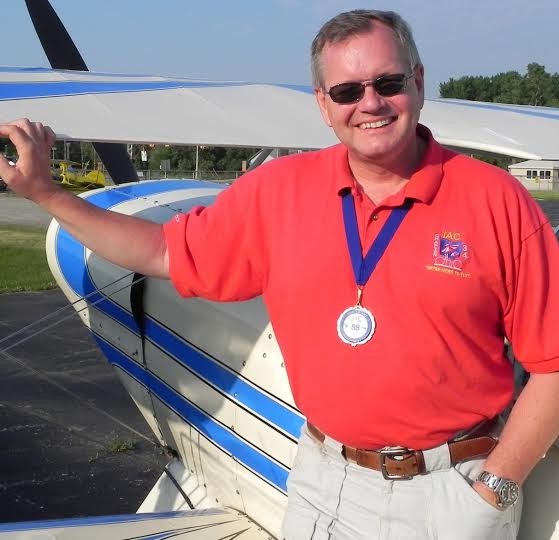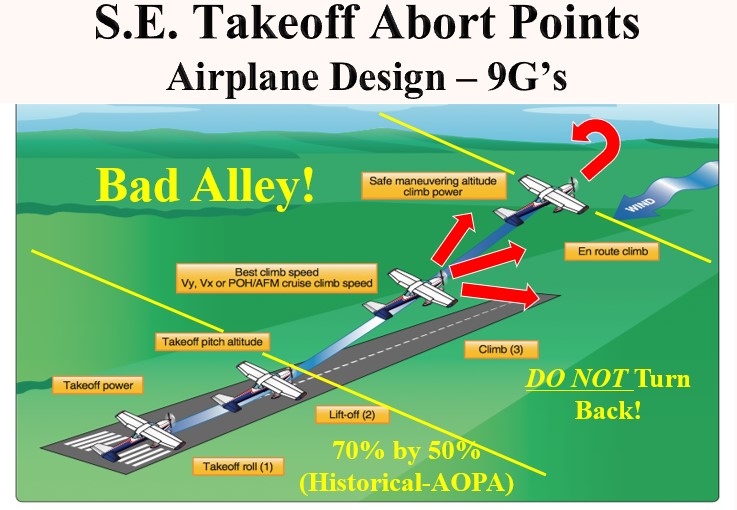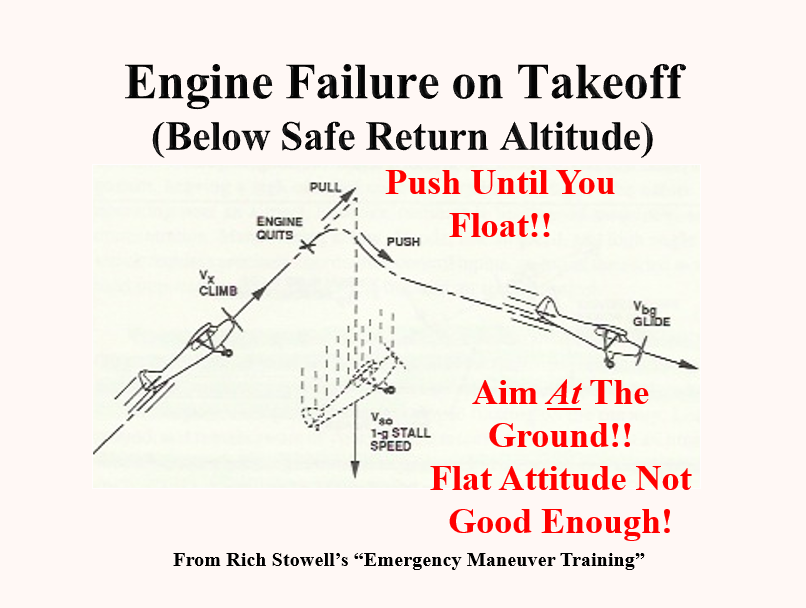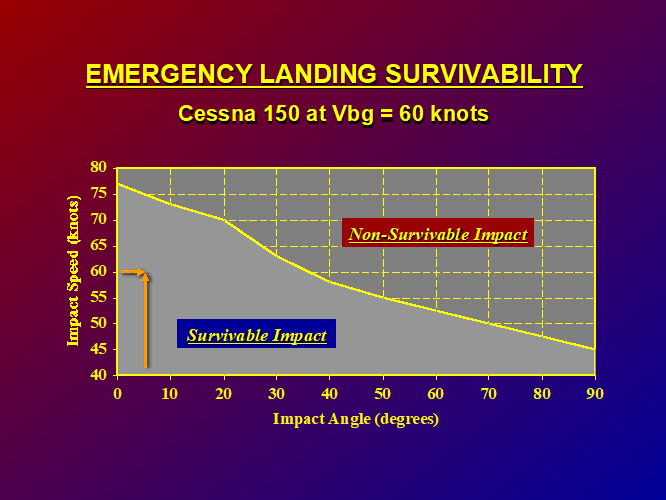Part 2 - Initial Climb
By Gordon Penner, FAA Gold Seal Instructor, 3-time MCFI-Aerobatic, SAFE Bronze Member

“Unless prepared in advance to make the proper decision, there is an excellent chance the pilot will make a poor decision, or make no decision at all and allow events to rule.” FAA Airplane Flying Handbook FAA-H-8083-3B
Overview
As we go into Part 2 of Decision Making and Loss of Control-Inflight accidents, or LOC-I, we will now talk about the phase of the takeoff from liftoff until reaching a safe turnaround altitude. This is the phase of takeoff where pre-planning your actions can exponentially increase your chances of success. This phase, unfortunately, has a high fatality rate, and is a phase we don’t think and train enough for.
“They” say to land somewhere ahead after engine failure on takeoff, but how do you make yourself do that, what factors must you overcome, and what are your chances of success? Just saying that you should do that is not enough. We must specifically think and train for it.
First, you are too low to make it back around. The siren call of the runway behind you is powerful, and it is seductive, but it is usually deadly.
Second, you must develop a “steely-eyed and harsh” attitude about this phase of your takeoff. You must decide, even before the throttle is pushed up, that if anything happens to your power on takeoff that you will sacrifice the aircraft to save the occupants.
Third, but probably most important, pilots are not regaining and maintaining their best glide speed (Vbg) after engine failure.
Lastly, crashing ahead is more survivable than you would think. We, the training industry, need to be more convincing about that.
This is a hard mental place for most to get to. Modern engines are so reliable. Plus, most pilots are either flying a rental or they are flying their own hand-built, five-years-in-the-making aircraft. The drive to save the airplane is HUGE! The drive to not crash, instead of to ‘crash well,’ is HUGE!
That is a lot to mentally overcome.
Be a pilot, not a passenger. Test pilot and airshow great Bob Hoover had a saying; “Fly the aircraft as far into the crash as you can.” He knows, because it happened to him. Also, the incident that follows was not his first.
In 1989 Bob Hoover lost power on both engines at approximately 300 feet above the ground in rough terrain flying his Shrike Commander outside of San Diego. He had two passengers on board. His piston-powered airplane had been mis-fueled with jet fuel instead of avgas.
Hoover maintained his airspeed, touched down wings level, and crashed up the side of a hill in a ravine. All aboard were uninjured.
Yes, he is THE Bob Hoover, but you know he pre-planned what he would do in this situation.
Background
For those of you just tuning in, the FAA is trying to reduce the LOC-I accidents because they are the leading cause of fatal accidents in General Aviation. They are finding that pilots out there are not only lacking stick and rudder skills, they are also making bad decisions (or no decisions) and not compensating for distractions.
The FAA declares that LOC-I: “Results from situations in which the pilot should have either maintained or regained control, but did not.”
Part 1 of this series was about LOC-I and Decision Making in general. Part 3 will discuss LOC-I when trying to return to the runway after engine failure, and how to determine a safe return altitude. Part 4 will be about LOC-I in the maneuvering, approach, and landing phases. Part 5 will cover botched Go Arounds.
The EAA has been working on the experimental side to reduce accidents and fatalities, with some success. In the January 2020 issue of ‘Sport Aviation’ Astronaut and columnist Charlie Precourt noted that the overall general aviation fatality rate was approximately 0.90 per 100,000 flight hours, which we need to bring down. In comparison, the experimental fatality rate went from 5.9 per 100,000 flight hours to 3.98. Nice reduction, but experimentals are still 4 times greater than regular GA to have a fatality. With this conversation we are trying to bring both numbers down.
Precourt suggested two possible reasons for the 1/3rd decrease in fatal accidents for experimentals. One is the APP, or the FAA’s Additional Pilot Program for Phase I testing of amateur-built aircraft. This allows builders to have an additional expert pilot with them during early testing. Homebuilts were having the highest fatalities in the first 8 hours of test flying. The APP has really helped in that area.
The second reason is the new EAA Flight Test Manual, of which 2,700+ have been sold so far. Precourt says the manual “…which provides a task-based approach to Phase I. …The idea is not to just fly off 40 hours on the new aircraft…but to methodically collect data that results in a complete pilot’s operating handbook for the aircraft.” Each takeoff task in the manual encompasses much of the planning we are about to cover below.
EAA is launching a second edition of the Flight Test Manual that will also speak to second owner/non-builders. Precourt shows they generate almost half of the experimental accident numbers.
We still have a lot of work to do
The illustrations that follow are from the FAA’s “Pilots Handbook of Aeronautical Knowledge,” the “Airplane Flying Handbook,” and the “Aviation Instructors Handbook,” and also from Rich Stowell’s “Emergency Maneuver Training” manual and “The Lightplane Pilots Guide to Stalls and Spin.”
Distractions and Decision Making
Distractions and decision-making mistakes are well covered in Advisory Circular 61-67C, titled “Stall and Spin Awareness Training.” This Advisory Circular can be downloaded for free from the faa.gov website. Please get it. I think it should be required reading for CFI’s, and it covers all things required for the Spin Awareness training in all the ACS’s and PTS’s.
Paragraph 101 of AC 61-67C says “Stalls resulting from improper airspeed management are most likely to occur when the pilot is distracted by one or more other tasks….Pilots at all skill levels should be aware of the increased risk of entering into an inadvertent stall or spin while performing tasks that are secondary to controlling the aircraft.”
The NTSB agrees. They say that most Stall/Spin accidents occur when the pilot’s attention was diverted from flying the aircraft. They also say that 20% of Stall/Spin accidents happened after an engine failure.
I recommend reading Charlie Precourt’s article “So, You Think You Can Make a 180 Back” article in the May 2020 issue of ‘Sport Aviation.’ In it he and contributor Rick Marshall showed that, from 2013 to 2018 NTSB data showed the following:
Below 1000 feet: “Of those who experienced these failures (engine failure on climb out) 30% tried to turn back. For those who turned back, 29% resulted in a fatality. For those who did not turn back, 8% were fatal. Furthermore, of those who tried to turn back, 70% were below 600 feet. And 52% of them resulted in a stall.” “…of those who stalled, 70% were fatal, while only 4% were fatal if there was no stall. Over the six years studied, of all those who tried to turn back, only one made it back to the runway after a total power loss.”
The 6 “P’s,” the “Knife Fight” and “The Bad Alley”
In the military they use an amusing phrase to drive planning for emergencies; The 6 ‘P’s.’ That stands for “Proper Planning Prevents Piss-Poor Performance.”
We define a superior pilot as one who uses superior planning to avoid having to use superior ability. A superior pilot trains to have those superior abilities in their safety and maneuvering “tool bag,” but then they plot and scheme to avoid having to pull those tools out of the bag.
The plotting and the scheming are the important points here!
The other part of a superior pilot’s skill set is awareness. It goes along with the old joke that says “What is the best way to win a knife fight in an alley? DON’T GO IN THE ALLEY!!!”
But, if we have to go into a bad alley, like on takeoff and initial climb, we must know how to recognize it early so we either don’t get in too deep, or how to get through it quickly.

The Bad Alley is represented in the above FAA AFH illustration. Everything in yellow, and the red arrows, I added. It starts at liftoff and ends at a “safe maneuvering altitude.” In the FAA Airplane Flying Handbook “safe maneuvering altitude” means when you could safely turn back to the runway, as do I. The determination of that point is controversial, as is how we accomplish the turn around, or even if we should try it at all. We will get to that in the Part 3 article. Again, Charlie Precourt has also covered this well in multiple articles during 2020 the EAA ‘Sport Aviation’ magazine.
We increase our awareness of the threat when we realize we are entering this bad alley every takeoff. The only way to avoid this alley is to not fly. To arm ourselves we must assume the engine will fail on takeoff and be ready. Our decisions must be made beforehand, and then adhered to religiously. Some of our options here are either bad or less bad, but more survivable than you think. More on that later.
I like what the FAA AFH says here. “What characterizes all power loss or engine failure occurrences after lift-off is urgency. In most instances, the pilot has only a few seconds after an engine failure to decide what course of action to take and to execute it. Unless prepared in advance to make the proper decision, there is an excellent chance the pilot will make a poor decision, or make no decision at all and allow events to rule.”
#1 Job - Push the Nose Down and Recapture Your Airspeed
I like Rich Stowell’s “Speed, Spot, Setup” mantra for engine out situations. Notice that speed is first.
I have observed that most pilots I have practiced the pushover maneuver with will not get the nose down in a positive enough manner, which requires a push – not just a relaxation, and they will also not get the nose down low enough. We will discuss how to determine how low is ‘low enough.’ For those of you that are super-smooth flyers you will find that you will have to be much more “assertive” than normal to regain, then maintain, your best glide airspeed (Vbg) after engine failure. Practice of this ‘push’ maneuver is essential. Most never have.
The first part of the climb out is where the airplane can be put back on the runway after engine failure and brought to a stop before running off the end.
The second part of the climb out is where you can land on the runway after engine failure but cannot get stopped before the end. In this case think beforehand which way you are going to turn when you get to the end of the runway or the airport boundary.
To that end I think single-engine pilots should be spanked for doing intersection takeoffs in most cases. Don’t get impatient. Do not give up the valuable resource of runway ahead of you in case of engine failure.
The third part of the climb out is where, after engine failure, both the touchdown and the stop are not on the runway.
I had said earlier that you not only need to make the decision before throttle is added about what to do in case of engine failure, but that you need to be positive/assertive in getting the nose down. See the illustration from Stowell’s EMT manual below. I added the notes in Red. This must be practiced at a safe altitude. It would be a shame to have runway under you to land on, but then stall and fall onto it due to failure to regain and maintain Vbg for the flare.

A pilot’s reaction time to any sudden occurrence is 4 - 5 seconds according to the FAA AFH. If decisions are made beforehand you might cut this number down by a second or two. During the reaction time window much airspeed will be lost with the nose up in the air, and it must be regained.
At engine failure you must push briskly enough to get light in the seat. Remember, if you are lighter, then so is the airplane. That means the stall speed is temporarily lower.
I recommend AOPA columnist Julie Boatman’s articles about the ‘push’ in 2006. In her experiments the stall came 4 times faster than for level flight with the nose up for a Vy climb with a simulated engine failure. The second article brought up the military concept of “unload for control,” getting light in the seat to maintain control and not stall.
How low must your nose go? Find the nose low attitude for Vbg in steady flight at idle. The nose must be lower than that to recapture Vbg.
Your glide angle will actually be slightly steeper with the drag of a windmilling engine compared to an idling engine. For those of you with controllable pitch props, going to coarse pitch with an engine out will slightly increase your glide. At low altitude you may not have time. Consult your POH.
Practice this attitude until the sight picture is memorized. Rich Stowell reminds us that the airspeed needle lags, so airspeed won’t help in the short time you may have. The needed nose low attitude will seem straight down, but that is a visual illusion. 10 degrees nose down will seem like 45. It will seem like you are aiming AT the ground, but it is not as nose low as you think.
Going from Vy in a climb to this nose low, ‘Vbg recapture’ attitude is quite a pitch change. That large movement contributes to the illusion. Once you recapture Vbg, maintain it to the flare, which may come quite quickly. A Vx, or Best Angle of Climb, takeoff attitude requires an even greater pitch change to recapture Vbg after engine failure. This practice will be an eye opener.
A climb at Vx, or halfway between Vx and Vy, may be necessary in some airplanes to get enough altitude close enough to the runway for a later return to the runway, assuming a safe return altitude is reached.
But, as Charlie Precourt showed in his ‘Sport Aviation’ articles, especially on a hot day, many aircraft can’t climb steep enough to get above their minimum required glide path back.
Flying and Surviving the “Crash”
Again, remember that if you lose an engine during the takeoff, if you go off airport the airplane WILL be damaged in act of saving yourself and your passengers. You simply must make this decision beforehand.
The reason why you shouldn’t try to turn back is for a few reasons. The biggest reason is that you don’t have the height to complete the 240 to 270 degrees of turn needed to make the “180’ back to the runway. The next is that the turnback can create a spin entry that has the same causes as the Base to Final turn accident. Lastly, if you land touching a wingtip first you will cartwheel. That is not survivable. See the "Avoiding the Base to Final Turn Accident" webinar HERE.(EAA login required)
People usually start a spin entry in this area because they don’t want to bank the airplane close to the ground, they are too low to make it all the way around, so they start “ruddering” the nose around. This is a spin entry.
Think of how frightening it is to see the ground coming up, and how much pressure there would be on you to ‘help’ the nose around. If the spin entry begins you may not be able to keep the wingtip from digging in first.
If you touch down wings level, however, and are not stalled, your chances of survival are actually quite good. It is counter-intuitive, but crashing straight ahead has a good statistical record of survivability.
So why, when the odds against success are so horrendous, do people try to turn back instead of crash ahead, even when they are quite low? I think we, the industry, do not do a good job in describing how well light planes are built for crashing within certain parameters.
But, really, think about it. How much sense does it make to the average pilot to suggest thinking about how to ‘successfully’ crash?
Rich Stowell’s EMT manual describes the crashworthiness of our light airplanes: “…with seats and restraint systems properly adjusted, occupants must be protected to at least the following static loads: 9.0 g’s in the forward direction, 3.0 g’s upward (4.5 g’s in the Acrobatic category), and 1.5 g’s sideways. Dynamic load test criteria include a 26 g’s deceleration in 0.05 seconds or less without seat or restraint system failures. Emergency landing survivability, therefore, can be improved simply by taking advantage of the crashworthiness designed into your airplane.”
The following chart is one Rich Stowell generated from data of a SAE (Society of Automotive Engineers) study about light plane crashworthiness.

Stowell, after much research, has found that “…low, slow and in the landing attitude with wings level offers the best chance or survival, regardless of the terrain.” Think back to Bob Hoover’s San Diego crash.
The FAA AFH show that landing at 50 mph and taking a 9G frontal deceleration will take about 10 feet. A landing at 100 mph will take about 40 feet. You really, really won’t like it much, but it is survivable.
Cartwheeling, however, will exceed your biological structural integrity. A split-second after the wingtip hits the ground the nose of the aircraft will pulled into the ground at touchdown speed with about a 70-80 degree impact angle. 60 knots at 70-80 degrees puts you on the Non-Survivable part of the graph above.
This data also shows the wisdom of wearing shoulder harnesses on takeoff and landing. You don’t want your head to ‘arrive’ at the instrument panel with 9G’s of force.
-------------------------------------------------------------
Next time I will talk about turning back to the runway after engine failure and how to, in some cases, figure out a decision altitude where it might be accomplished safely. Beware. That “safe maneuvering altitude” might be higher than you think. Also, on a hot day this minimum altitude still may not work for you because you’ll be much farther downrange and beyond gliding range.
After that I will talk about alleys to avoid on approach and landing, and botched Go-Arounds.
Fly Safe!!

